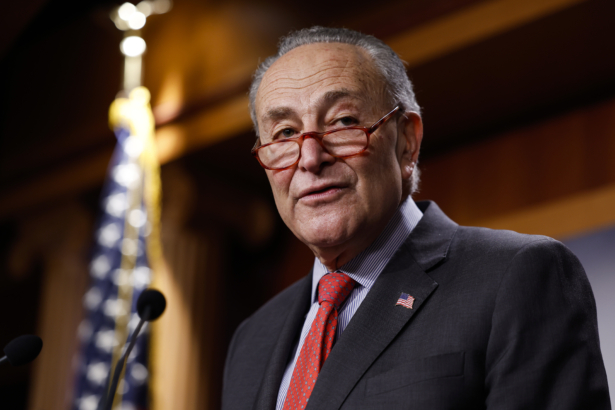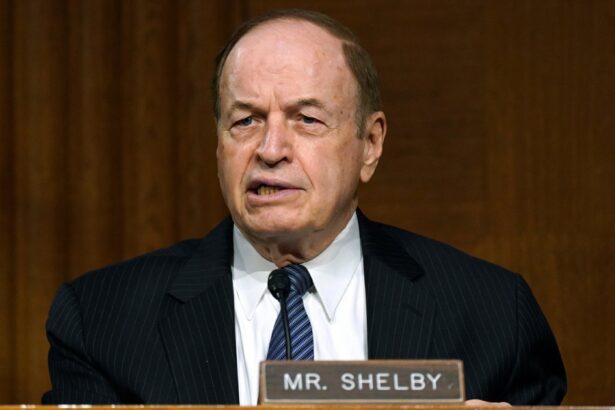Lawmakers have at long last unveiled the legislative text of the huge $1.7 trillion “omnibus” government funding bill for all of fiscal year 2023, with apparent wins for both parties like boosting non-defense discretionary spending, while keeping restrictions on funding abortions.
Senate Appropriations Committee Chairman Patrick Leahy (D-Vt.) released the bill (pdf) late Monday, urging members of the House and Senate to take up the 4,155-page bill and “pass it without delay” as government funding is set to expire on Dec. 23 at midnight and a shutdown looms.
“The choice is clear. We can either do our jobs and fund the government, or we can abandon our responsibilities without a real path forward,” Leahy said in a statement. “Passing this bipartisan, bicameral, omnibus appropriations bill is undoubtedly in the interest of the American people.”
The full-year government funding bill, commonly known as an “omnibus” for its catch-all scope that funds multiple federal agencies, is first expected to be taken up by the Senate for possible passage by Thursday, then to the House, and later to President Joe Biden’s desk for a signature by Friday’s deadline.
Failure to pass the legislation could bring a partial government shutdown beginning Saturday and potentially lead to a months-long standoff after Republicans assume control of the House on Jan. 3, ending the Democrats’ monolithic grip on power in Washington.
The bill is the product of long-running negotiations between Democrats and Republicans in Congress, which ran into less routine sticking points like the location of the new FBI headquarters and more standard fare like the GOP pushing back on what it views as wasteful pork-barrel spending on programs unrelated to defense.
On Dec. 14, Senate Republican Leader Mitch McConnell (R-Ky.) said that,”Republicans simply were not going to lavish extra-liberal spending” on non-defense programs into the omnibus bill.
On Dec. 15, Sen. Chuck Schumer (D-N.Y.), the top Democrat in the Senate, said last week that, “nobody is going to get everything they want, but the final product will include wins everyone can get behind.”

Leahy said Monday that the bill “is the product of months of hard work and compromise” and thanked Senate Appropriations Committee Vice Chairman Richard Shelby (R-Ala.) and House Appropriations Committee Chair Rosa DeLauro (D-Conn.) for “their partnership and hard work.”
The full details of the package were being crafted over the weekend, with the draft released late Monday showing that the legislation includes $772.5 billion for non-defense discretionary programs and $858 billion in defense funding.
There’s also $44.9 billion in emergency assistance to Ukraine and America’s NATO allies.
Both Parties Claim Wins
Members of both parties claimed their own victories in the sprawling bill.
Democrats’ wins include increased clean energy funding, more money for nutrition and child care programs, as well as funding boosts for various homeless and housing initiatives.
Republican victories include retaining longstanding restrictions on funding for abortions and trimming funding for the Internal Revenue Service (IRS).
The IRS is set to receive $12.3 billion, a $275 million cut from the prior year’s level, a welcome development for Republicans who were upset over the $80 billion funding boost for the tax agency outside the regular appropriations process in a bill earlier this year that passed without GOP backing.
McConnell on Monday touted the deal as a win for Republicans because the omnibus funding package raises defense spending above the rate of inflation while increasing non-defense spending at a lower rate than inflation. This means that non-defense spending is getting a cut in real, inflation-adjusted terms.

Speaking on the Senate floor, McConnell said when the Biden administration first proposed the funding bill, it wanted to cut defense funding “while massively increasing spending on non-defense.”
“Republicans have taken the president’s bizarre position and flipped it on its head,” McConnell said, adding that the GOP wasn’t “going to let our Democratic colleagues demand extra left-wing goodies in exchange for doing their job and funding our troops.”
By contrast, Senate Democratic Whip Dick Durbin (D-Ill.) said Monday that he’s disappointed that non-defense social spending programs will get a smaller bump than defense, according to The Hill.
“I don’t like it but we’re in a pretty desperate situation,” Durbin said, presumably referring to the Democrats’ loss of political leverage by losing control of the House to Republicans in the midterm elections.
Shelby praised the deal for raising non-defense funding by “only 5.5 percent,” which is lower than the rate of inflation and around half the boost the Biden administration had asked for in its “wasteful” request.
“This process was far from perfect, but ultimately it allowed Republican redlines to be adhered to and because of that I will urge my colleagues to support this package. We need to do our job and fund the government,” Shelby added.

Details
A topline summary (pdf) of each of the omnibus package’s 12 appropriations bills shows that all are slated for increases to varying degrees.
Agriculture-FDA (pdf): $25.48 billion, a $355 million increase compared to the fiscal year 2022 funding level;
Commerce-Justice-Science (pdf): $83.85 billion, an $8.1 billion increase;
Defense (pdf): $797.7 billion, a $69.3 billion increase;
Energy and Water (pdf): $54.65 billion, a $1.778 billion increase;
Financial Services (pdf): $27.699 billion, a $2.067 billion increase;
Homeland Security (pdf): $60.7 billion, a $3.2 billion increase;
Interior-Environment (pdf): $40.45 billion, a $2.45 billion increase;
Labor-HHS-Education (pdf): $209.9 billion, a $14.8 billion increase;
Legislative Branch (pdf): $6.9 billion, a $975 million increase;
Military Construction-VA (pdf): $135.2 billion in discretionary funding and $168.6 billion in mandatory funding, representing a combined increase of $34 billion;
State and Foreign Operations (pdf): $61.758 billion, a $3.76 billion increase;
Transportation-HUD (pdf): $90.955 billion, a $9.917 billion increase.
Funding for bipartisan priorities includes $58.7 billion for programs authorized by the Infrastructure Investment and Jobs Act; $1.8 billion in new funding to implement the CHIPS and Science Act of 2022; and $5 billion for the Cost of War Toxic Exposures Fund to implement the PACT Act.
The package also includes $47.5 billion for the National Institutes of Health; $9.2 billion for the Centers for Disease Control and Prevention; $1.5 billion for ARPA-H; and $950 million for the Biomedical Advanced Research and Development Authority.
There’s also a $13.4 billion increase for the Supplemental Nutrition Assistance Program; $28.5 billion for Child Nutrition Programs; and $6 billion for the Special Supplemental Nutrition Program for Women, Infants, and Children.
The omnibus package includes funding for a number of housing assistance initiatives, including $3.6 billion for Homeless Assistance Grants; $2 billion for the Rural Housing Service; $1.5 billion for the HOME Investment Partnerships Program; and $1.4 billion for the Housing for the Elderly and Housing for Persons with Disabilities program.
Education-related funding includes boosting the maximum Pell Grant award to $7,395, as well as $18.4 billion for Title I-A grants, and $1.2 billion for TRIO to support low-income first generation college students.
There are also child care investments, including $7.7 billion for the Child Care and Development Block Grant, and nearly $12 billion for Head Start.
The bill also provides $5 billion for the Low Income Home Energy Assistance Program to help families with high energy costs, and a record $700 million for combating violence against women.
From The Epoch Times

